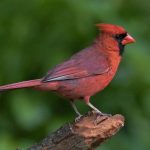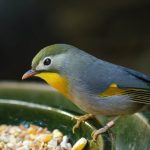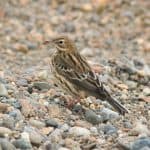Common Name: Red-whiskered Bulbul
Scientific Name: (Pycnonotus jocosus)| Size | Diet | Range in Hawaii | Status in Hawaii |
|---|---|---|---|
| 8 in. | berries, insects and nectar | O'ahu | Least Concern |
The Red-whiskered Bulbul, also known as Pycnonotus jocosus, is a songbird species that is native to South and Southeast Asia. While the species is not native to Hawaii, it has been recently established and is considered a naturalized (non-native) resident of the islands. With its striking appearance and melodious song, the Red-whiskered Bulbul is a fascinating bird species that has captured the attention of birdwatchers and avian enthusiasts around the world.
In this article, we will explore the world of the Red-whiskered Bulbul, its unique characteristics, and its presence in Hawaii.
Red-whiskered Bulbul
Appearance
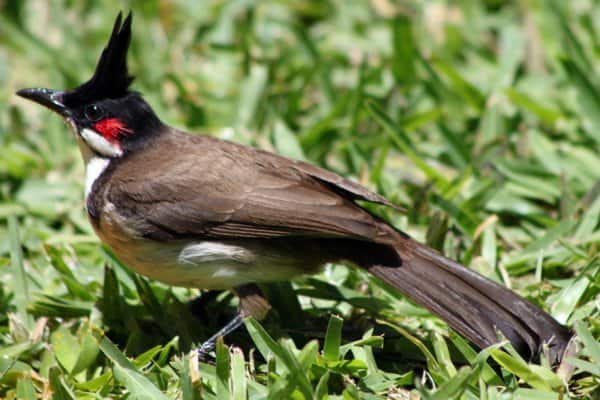
The Red-whiskered Bulbul is a captivating avian wonder known for its striking appearance. This songbird, measuring about 8 inches in length, showcases a vibrant blend of colors. Its distinctive red patch located just behind its eye contrasts beautifully with its sleek black crest and throat.
The rest of its body features a soft olive-green hue, complementing the vivid red feathers and creating an eye-catching ensemble. With its charming presence and unique color palette, the Red-whiskered Bulbul is a delightful sight for bird enthusiasts and nature lovers alike.
Diet
The Red-whiskered Bulbul boasts a diverse and eclectic palate. This charming songbird has a penchant for a wide array of foods, making its diet a captivating mix of flavors. From succulent fruits and berries to delectable insects and nectar, the Red-whiskered Bulbul navigates its environment with a culinary curiosity.
Nesting
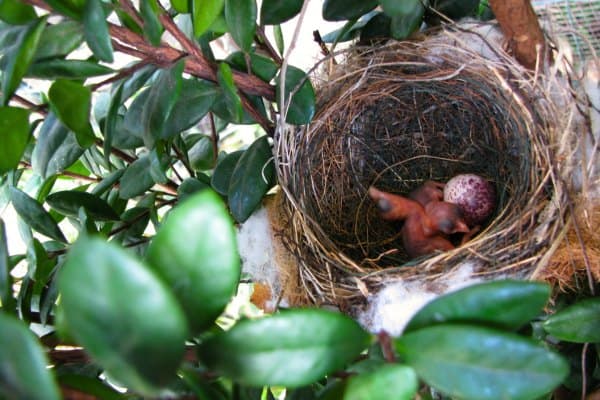
Using an assortment of materials ranging from twigs and leaves to spider silk and human-made fibers, the Red-Whiskered Bulbul weaves a structural marvel that speaks volumes about its innate engineering prowess. Their nests are perfectly designed to cradle their precious eggs, providing both security from predators and optimal conditions for incubation.
As dawn breaks, the air is filled with the melodious symphony of the male bulbul, whose red-tipped whiskers give him his name, serenading potential mates with a song that rivals the sweetest melodies. Once a pair bonds, their partnership extends to the intricacies of parenting.
The female painstakingly lines the nest with soft materials, creating a cozy haven for the delicate eggs. The male joins in, sharing the responsibility of incubation and guarding the nest with unwavering dedication.
Behavior
Social by nature, these bulbuls create a lively and dynamic atmosphere wherever they go. Their melodious calls, resembling a fusion of musical notes and chirps, fill the air as they communicate with fellow bulbuls, asserting their territory and flirting with potential mates. These captivating vocalizations often become an inseparable part of the background symphony in gardens and woodlands alike.
Renowned for their playful antics, Red-Whiskered Bulbuls engage in an array of acrobatics, hopping and flitting through branches with the agility of seasoned performers. Their joyful demeanor is infectious, as they engage in communal activities like preening each other’s feathers, a symbol of their strong social bonds.
These omnivores relish a diverse diet that showcases their adaptability to varying food sources. In doing so, they play a pivotal role in dispersing seeds and pollinating flowers, contributing to the health of their ecosystems.
Nesting behavior further unveils the dedication of these bulbuls. Their nests, meticulously crafted from a medley of natural and human-made materials, showcase their resourcefulness and attention to detail. Mates collaborate seamlessly in nest construction, incubation, and the subsequent nurturing of their young, creating a heartwarming example of teamwork in the avian world.
Habitat
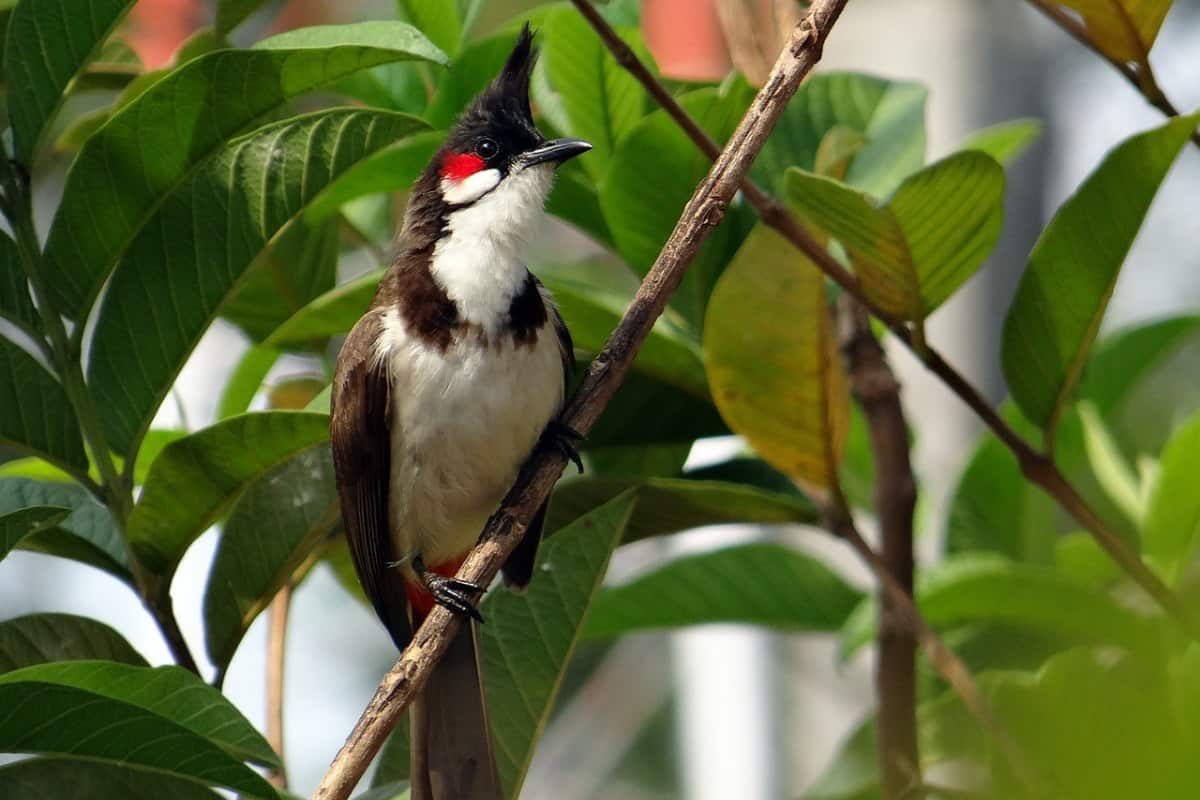
The Red-Whiskered Bulbul finds its habitat amid diverse landscapes, from tropical gardens to forested woodlands. Remarkably, they’ve embraced urban life, nesting on balconies and rooftops, intertwining nature with the bustling city. With a fondness for trees, they sing from branches, showcasing their vibrant existence against the backdrop of leaves and sky.
Range
The Red-whiskered Bulbul, originally from southern China, has established itself in Hawaii, specifically on the island of O’ahu. Introduced in the mid-1960s, these charming songbirds have gradually spread from Makiki Heights to areas such as Aiea, Kaneohe, Kailua, Waimanalo, and beyond. They’ve become a notable part of O’ahu’s avian landscape, contributing to the island’s unique biodiversity.
Conservation Status
The Red-Whiskered Bulbul (Pycnonotus jocosus) holds a status of “Least Concern” according to the International Union for Conservation of Nature (IUCN). This indicates that, at a global level, the species does not currently face imminent threats to its survival.
Interesting Facts
1. Mimics and singers
Red-Whiskered Bulbuls are talented mimics. They can imitate a variety of sounds, including the calls of other birds and even mechanical noises. Their melodious songs are a mix of whistles, trills, and chirps.
2. Invasive species
In some regions, like parts of Australia, the Red-Whiskered Bulbul is considered an invasive species. Their introduction can potentially disrupt local ecosystems and native bird populations.
3. Molt patterns
These bulbuls undergo molting, during which they shed and replace their feathers. Molting can affect their appearance, and some individuals might temporarily lose their red whisker markings.
4. Cultural significance
In some regions, the Red-Whiskered Bulbul holds cultural significance and is even considered a lucky charm or symbol of good fortune.
5. Urban “Alarm clocks”
Their melodious morning calls have earned them the nickname of “urban alarm clocks” in some areas, where their vocalizations mark the beginning of each day.
Frequently Asked Questions
1. What is the significance of the “red whiskers” on the Red-Whiskered Bulbul?
The red streaks beneath the eyes of the Red-Whiskered Bulbul are its most distinctive feature, giving it its name. These red markings serve as a visual identifier and are used in communication within their social groups.
2. Can Red-Whiskered Bulbuls mimic human sounds?
Yes, these bulbuls are talented mimics. They can imitate a wide range of sounds, including other bird calls, mechanical noises, and even human speech or melodies. Their ability to mimic sounds from their environment contributes to their vocal repertoire.
3. Are Red-Whiskered Bulbuls kept as pets?
While they have vibrant personalities and melodious songs, keeping wild birds as pets is generally discouraged due to ethical and conservation reasons. It’s important to appreciate these birds in their natural habitats.
4. What’s the lifespan of a Red-Whiskered Bulbul?
In the wild, their lifespan is typically around 5 to 7 years. Factors such as predation, food availability, and environmental conditions can influence their longevity.
5. How can I contribute to Red-Whiskered Bulbul conservation?
Supporting local habitat conservation efforts, refraining from capturing or keeping them as pets, and spreading awareness about their ecological importance can all contribute to the well-being of Red-Whiskered Bulbuls and their habitats.

